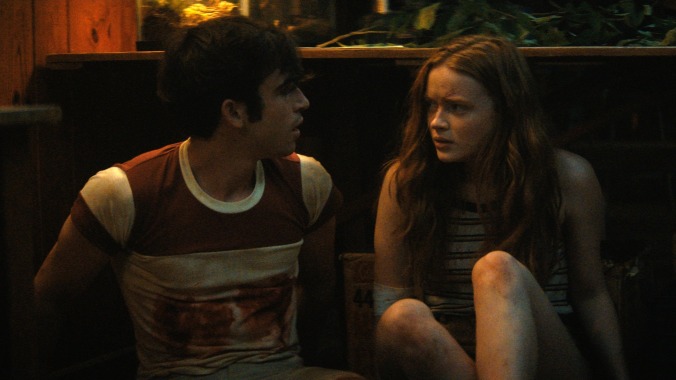Fear Street goes back to 1978 for a gory but plodding Friday The 13th riff
The middle chapter of Netflix's R.L. Stine franchise forgets the fun of slashers past


Of all the demographics pandered to by the Fear Street movies, gorehounds may be alone in getting their streaming subscription’s worth. The first film in Netflix’s trilogy, loosely inspired by the R.L. Stine book series of the same name, climaxed with one of the killers feeding a cheerleader’s head through a produce shredder. One week later, the second installment ups the grisly ante with severed noggins, bones jutting gruesomely out of ankles, and a giant, throbbing, disembodied heart. The uptick in splatter makes sense, given the era of horror evoked this time: that long stretch of post-Halloween blood-and-guts programmers, whose entire reason for being was finding outrageous new ways to off horny teenagers. Two out of three entries into the series, Fear Street is staying true to the gross-out spirit of its predecessors, while feeling in just about every other way like the Urban Outfitters take on them.
As its subtitle indicates, Fear Street Part Two: 1978 trades one theme-park, costume-party vision of a bygone decade for another: While Part One followed the wokest, hippest small-town Midwestern kids of 1994, this middle installment rewinds back to an earlier massacre at a summer camp, where a different group of out-of-time teens cosplay another generation’s style and vernacular. Like their ’90s counterparts, the young adults of Camp Nightwing have a halo of invisible scare quotes hovering around them as they mumble out “Shagadelic” like the extras in an Austin Powers movie. Perhaps aware of how vaguely anachronistic her stars look and sound, returning director Leigh Janiak overcompensates again with a mixtape, piling The Runaways on top of Blue Oyster Cult on top of Davie Bowie. (In what counts as the only halfway clever use of music so far in this trilogy, she deploys alternate versions of “The Man Who Sold The World” to situate us in one time period and then the other.)
1978 frames its action as a very long flashback—a story told to the survivors of the last movie’s rampage by a survivor of this movie’s. Indie kid Deena (Kiana Madeira) and dorky little brother Josh (Benjamin Flores Jr.) learn that in ’78, two different siblings grappled in different ways with their dysfunctional home life. Ziggy Berman (Sadie Sink) is the black sheep, tormented by her peers for her rebellious streak, though this Shadyside troublemaker isn’t so bad that she can’t catch the eye of rival town Sunnyvale’s future police chief (Ted Sutherland), who we know is the head cop we met in the previous film because characters literally call him “future police chief.” Ziggy’s sister, Cindy (Emily Rudd), has meanwhile tacked in the opposite direction, doing the reverse Sandy Olsson, though her supposed makeover into a prep princess mainly comes down to the fact that she wears polo shirts now. (Everyone else in the movie looks like they went rummaging thorough Mom and Dad’s wardrobe.)
It’s Cindy’s boyfriend, generic hunk Tommy Slater (McCabe Slye), who goes berserk one fateful night at camp, taking an axe to counselors and campers alike. He’s possessed by the ghost of town legend Sarah Fier, who was hanged centuries earlier—a backstory that will be further explored in next week’s trilogy-capping 1666, presumably to a soundtrack of righteous Baroque needle drops. The rules of Fier’s mayhem are kind of convoluted: The witch can turn kids into brainwashed psycho killers without provocation, but it takes a convenient drop of blood on her conveniently exposed remains to raise a posse of undead slashers, all going It Follows on whoever inadvertently summoned them. If you squint, the sordid history of Shadyside resembles a teen-lit gloss on one of Stephen King’s haunted Maine towns—and of course, the “R.L. Stine for adults” gets name-checked by a couple of self-aware teens here.
Speaking of Stine, his Fear Street privileged melodrama as much as scares, which may account for the general soapiness of these movies, whose high-school heroes/victims spend as much time shrilly shouting at each other as they do screaming bloody murder before their bloody murders. In 1978, it takes an interminable 45 minutes to get to the slashing. At least the movie leans fairly hard into the nastiness from there: This is a grosser and meaner film than 1994, dumping buckets of both blood and squirming insects on its squeaky-clean ensemble. The sadistic streak actually goes a touch further than it did in some of the movies that inspired this one, given Janiak and her cowriters’ willingness to drop the blade onto not just the humping-and-blazing counselors but also their barely pubescent charges. (Not even the Friday The 13th series dared to dismember tweens the way this movie does, albeit offscreen.)
Last week’s 1994 began with a tribute to Scream—a courted comparison that did the new movie no favors. 1978 benefits from a lower bar to clear: Even the president of the Jason Voorhees or Angela Baker fanclub would likely concede that the majority of the films indistinctly echoed here are no masterpieces. Yet if this homage is better written, directed, and acted than plenty of slashers that came before, it rarely revives the grimy or campy fun of its genre. And that’s because Janiak, for all her plain skill behind the camera, doesn’t invest in its conventions, or make a meal out of the stalk-and-slaughter set pieces; the kills come and go with a perfunctory swiftness that suggests a condescension to the material, not a genuine affection for it. That’s why the gore feels like scant reward: There’s plenty of blood but no heart put into pumping it.